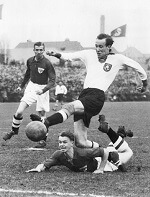Trouvez vos billets
OUR ADVANTAGES






The Origin of Football

The Origin of Football
According to the Pew Research Center, nearly 3.2 billion people tuned in to watch the 2010 World Cup in South Africa, if only for a minute.1 That means almost half the world’s population is interested in football. This should come as no surprise; football didn’t just become a popular sport overnight. For thousands of years, human beings have enjoyed kicking spherical objects around with their feet. The rules and the ball itself may have changed over time, but the essential competitive spirit of the game has remained the same.
FOOTBALL IN ANCIENT TIMES
Scientific records suggest that some version of football was played over 2000 years ago, most notably in Ancient Rome, Greece and China.
The Romans - When they weren’t busy conquering the world or inspiring people to “do as the Romans do,” the Romans played a game known as “Harpastum,” the object of which was to keep hold of a small ball for as long as possible.
The Greeks - The ancient Greeks loved cosmopolitanism, the theatre and a game called “Episkyros," which was similar to both football and rugby.
The Chinese - “Cuju,” which translates as “kick ball,” is the earliest form of football that’s been recorded. According to those records, you could move the ball with any part of your body but your hands. The objective was to kick the ball through a net that was suspended 30 feet from the floor. Cuju rules were formed and standardised during the Han Dynasty, which lasted from 206 B.C.E. to 220 C.E.
FOOTBALL IN EUROPE
Modern-day football originated in Europe, but the first games weren’t played with your run-of-the-mill rubber ball. According to legends that predate the medieval period, two villages would kick a human skull back and forth, and a village would “score” whenever they kicked the skull into the opposing village’s central square.
That certainly gives new meaning to the phrase "keep your head in the game."
One medieval custom was to use inflated pig bladders as a ball. In this version of the game, the object was to keep the “ball” from touching the ground, but you could use both your hands and your feet.
Football rules began to be set in place in Britain’s public schools during the 16th century. Private schools began using the name “football” to describe the sport, even though there were moments when you were allowed to use your hands. You were even allowed to grab your opponent. Goals, without posts, and goalies were also introduced during this period.
In the 1700s, football clubs were forming and competing against each other. You could still use your hands at certain times, and you were only allowed to pass the ball backwards. It wasn’t until 1863 that the Football Association brought together all of Britain’s various football rules and combined them to form one standardised set of regulations.
Football has certainly come a long way from skulls being kicked back and forth. It makes one wonder if the sport is done evolving or if greater technological innovations could be introduced at some point. Perhaps our rubber footballs will seem strange to the people of the future, just like inflated pig bladders seem strange to us.
(Photo via NationalMuseet)
Recherches tendances
























































































